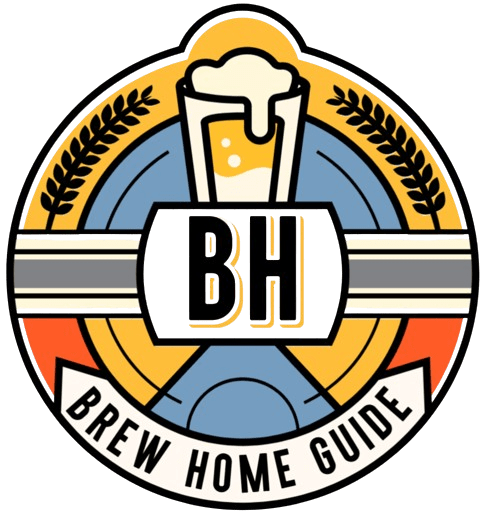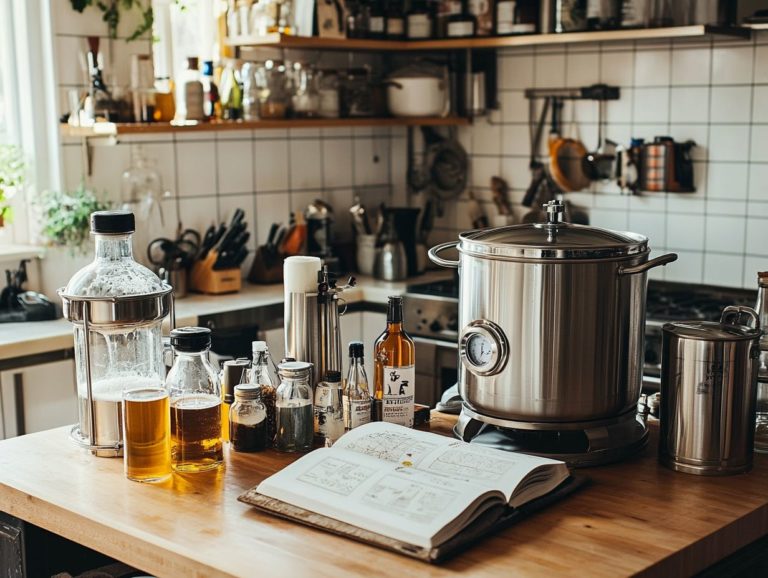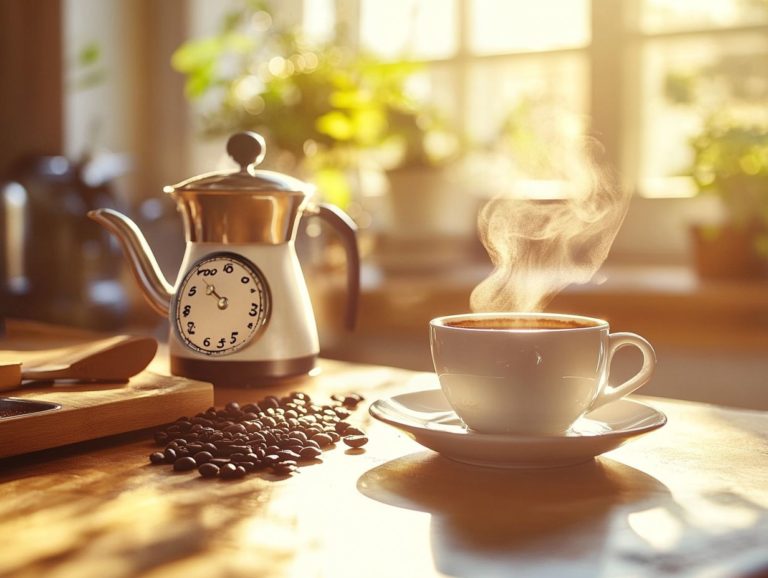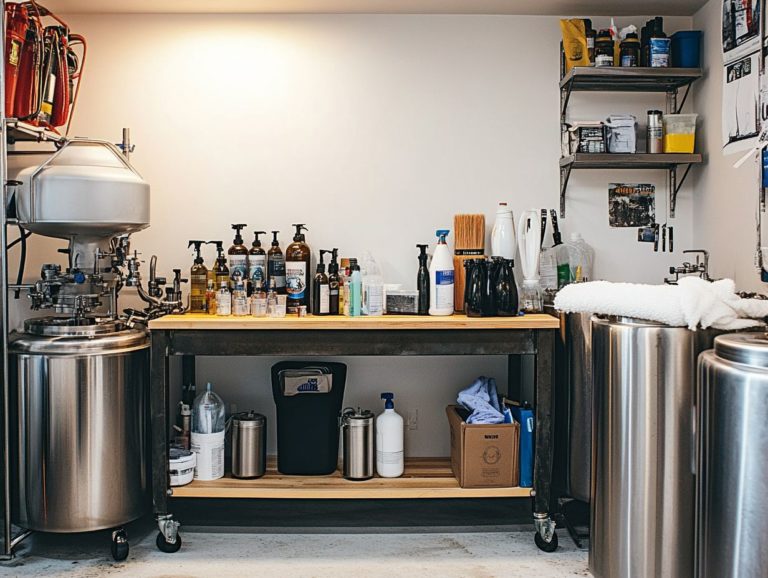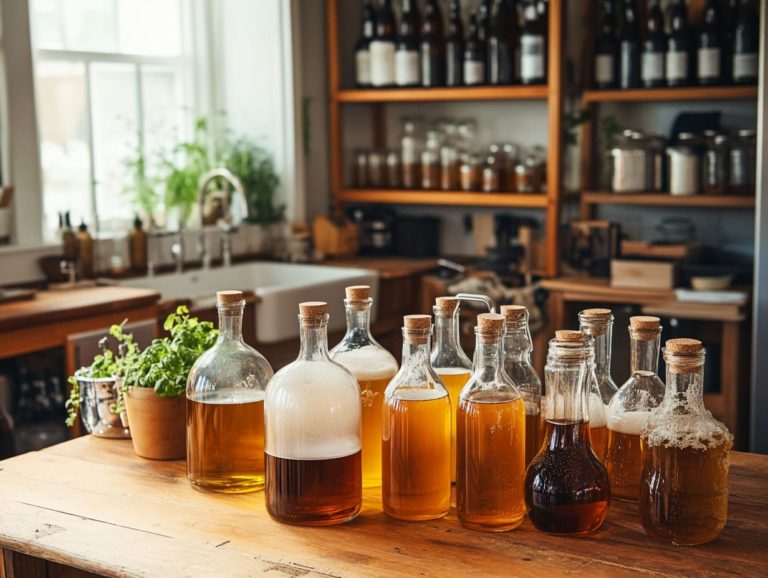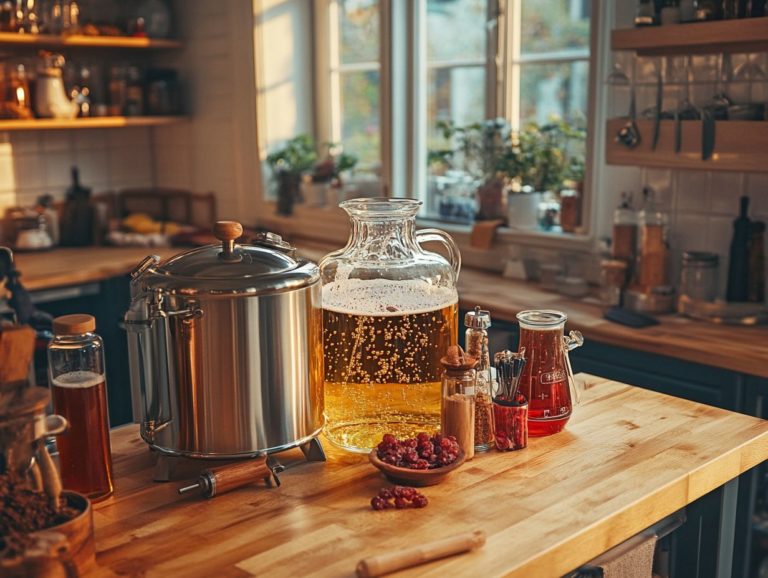How Do I Know If My Beer Is Overcarbonated?
Contents
- Understanding Overcarbonation in Beer
- Tips for Avoiding Overcarbonation in Homebrewing
Understanding Overcarbonation in Beer
Have you ever opened a bottle of beer only to be greeted by a foamy overflow? Don t let overcarbonation ruin your brew! Overcarbonation in beer can transform a delightful brew into a foamy disaster, leaving both homebrewers and beer aficionados scratching their heads. Grasping the causes of this bubbling conundrum is essential for anyone striving for perfection in their craft. Whether you’re using traditional bottling or exploring modern techniques like keg forced carbonation, understanding the nuances is key.
A number of factors, from fermentation mishaps to contamination and improper storage, can contribute to excessive carbonation. This article delves into the signs of overcarbonation, its repercussions, and most crucially how to prevent and remedy the situation, ensuring your beer stays enjoyable and perfectly balanced. Resources like Craftabrew.com and Skillafizer can offer valuable insights into mastering these aspects.
Key Takeaways:
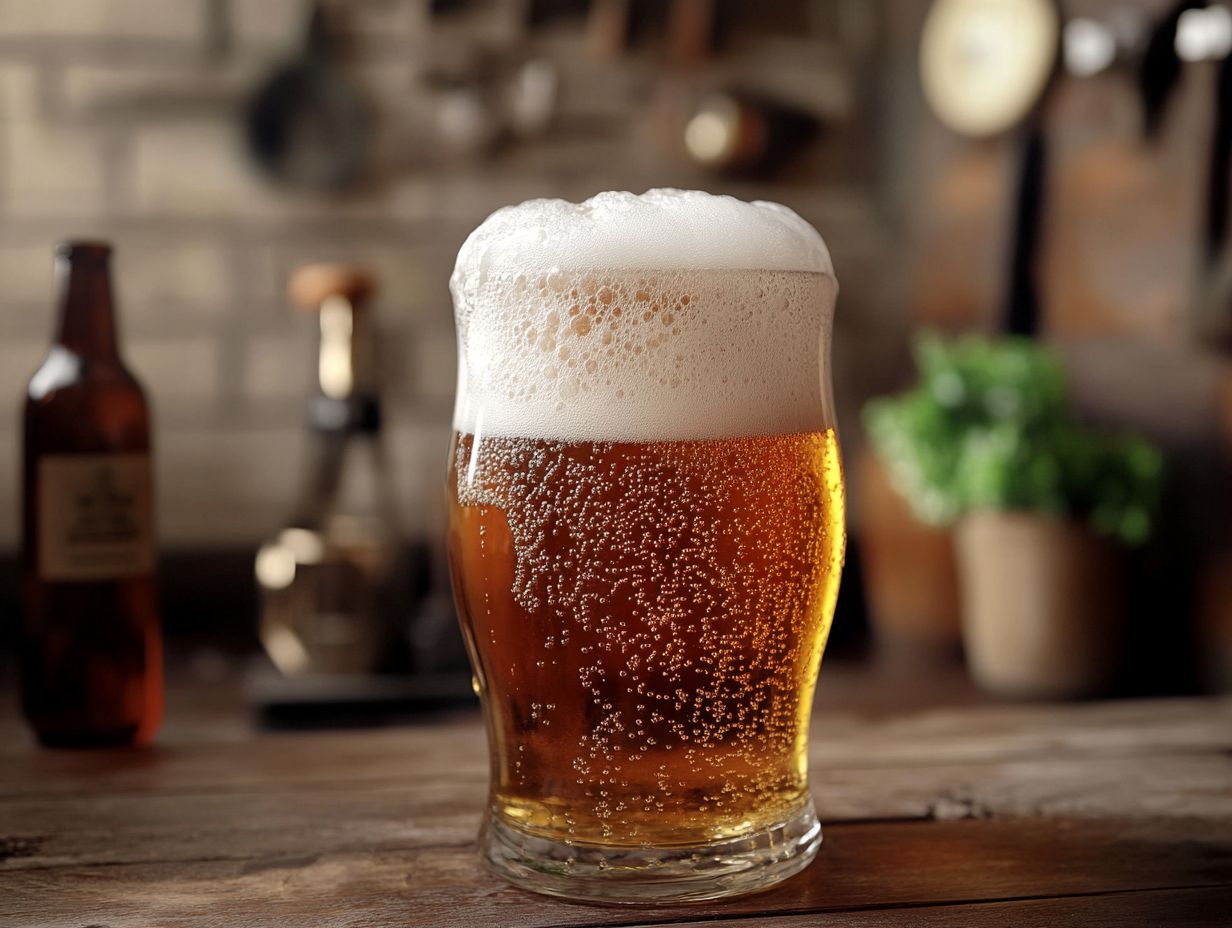
- Excessive foam, gushing beer, and bottle explosions are signs of overcarbonation in beer.
- Overcarbonation can be caused by fermentation issues, contamination, or improper storage.
- To prevent overcarbonation, use proper fermentation techniques, sanitize equipment, and store beer correctly.
- Consider cold crashing your beer, which means cooling it quickly before bottling to help settle out sediment and improve clarity.
- Use a carbonation calculator to determine the exact amount of priming sugar needed.
What Is Overcarbonation?
Overcarbonation is the excessive accumulation of carbon dioxide in beer, and it can significantly detract from your drinking experience. This issue arises when the brewing process encompassing fermentation and carbonation is not meticulously managed, leading to undesirable carbonation levels that could result in bottle bombs or gushing beer. Using a bottling bucket can help manage this stage more effectively.
A solid understanding of overcarbonation is essential for homebrewers and beer enthusiasts alike, especially if you’re aiming to achieve the ideal carbonation in your favorite styles, such as American Pale Ale or New England IPA. Craftabrew.com provides excellent resources and supplies for those looking to perfect their brewing techniques.
What Causes Overcarbonation in Beer?
Overcarbonation in beer can arise from a multitude of factors that disrupt the intricate brewing process, often resulting in less than desirable outcomes. This can affect various beer styles, from Belgian Dubbel to California Common.
You might encounter common culprits such as fermentation issues think incomplete fermentation or using too much priming sugar. Contamination from wild yeast or bacteria can also play a role, as can improper storage conditions that intensify carbonation problems. Utilizing tools like a carbonation calculator can help in determining the right amount of priming sugar.
Grasping these nuances is essential for any homebrewer or craft beer enthusiast striving to refine their brewing techniques and mitigate the risks linked to overcarbonation.
1. Fermentation Issues
Fermentation issues often stand at the forefront of overcarbonation problems, frequently stemming from an excess of priming sugar or incomplete yeast fermentation. If yeast doesn t fully convert the sugars, extra carbon dioxide can build up, creating unwanted pressure in the bottle and the risk of bottle bombs. Understanding the fermentation process is crucial for identifying potential bottlenecks.
To sidestep such predicaments, it s essential to closely monitor yeast activity throughout the fermentation journey. This means regularly measuring sugar levels to confirm they re decreasing, which indicates that the yeast is diligently consuming them. Employing a carbonation calculator can help in determining the optimal amount of priming sugar required.
Ensuring fermentation reaches its full conclusion before bottling is crucial; any residual sugars can lead to unwanted carbonation. Utilizing carbonation calculators can be immensely helpful in determining the precise amount of priming sugar required for carbonation, enabling you to navigate the complexities of overcarbonation while achieving that perfect level of fizziness in your craft beverages. Understanding bottling tips can also help you achieve the desired results.
2. Contamination
Contamination during the brewing or bottling process presents serious challenges. It can introduce wild yeast or bacteria that disrupt fermentation and lead to overcarbonation. This kind of contamination jeopardizes not only the flavor profile of your beer but also raises the risk of bottle bombs resulting from uncontrolled fermentation.
Microorganisms like Lactobacillus and Brettanomyces can wreak havoc on your brewing efforts. They result in off-flavors and undesirable sourness. These organisms thrive in unclean brewing environments, and if not eliminated promptly, they can ruin an entire batch. Regularly using sanitizing agents like StarSan can significantly reduce infection risks.
Infected beer can cause serious problems, including unpleasant aromas and even dangerous bottle explosions when carbonation levels spiral out of control. That’s why maintaining a rigorous sanitization regime is essential for preserving the integrity of your brew. Employ proper brewing techniques and use tools from platforms like Craftabrew.com to avoid these pitfalls.
Using effective sanitizing agents like StarSan dramatically cuts down contamination risks, ensuring your brewing adventure is safe and enjoyable!
3. Improper Storage
Improper storage conditions are a crucial factor that can lead to overcarbonation. Fluctuations in temperature directly affect how well carbon dioxide stays dissolved in your beer. When you store your beer in warmer conditions, carbon dioxide is more likely to escape into the headspace, increasing pressure and raising the risk of bottle bombs when you finally pop one open.
To maintain optimal carbonation, regularly check your storage conditions. Keep your bottles in a consistent, cool environment. Ideally, aim for a temperature range of 45 to 55 degrees Fahrenheit to keep your beer stable and prevent any unwanted fermentation activity. Investing in a dedicated beer fridge or a climate-controlled cellar can greatly assist in achieving this ideal temperature.
Storing your bottles upright is another smart move; it minimizes oxidation and sediment disruption, both of which play a significant role in flavor preservation. Regularly monitor your storage conditions and adjust as needed to keep temperature fluctuations to a minimum for the best possible results.
How Can You Tell If Your Beer Is Overcarbonated?
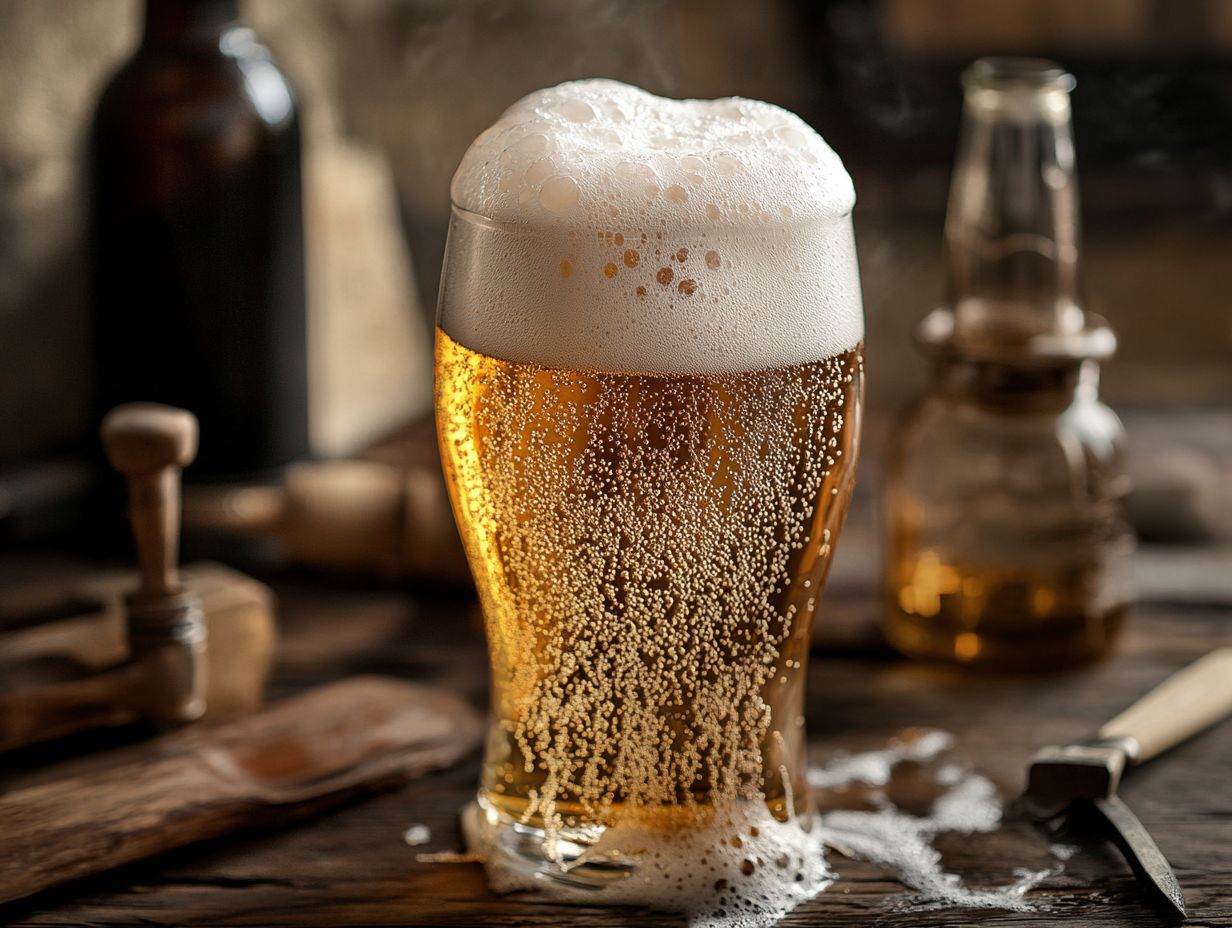
Identifying overcarbonation in your beer is essential to prevent unwelcome surprises when you pop open a bottle. Look out for telltale signs such as excessive foam, gushing beer, and the alarming possibility of bottle explosions. These all point to carbon dioxide levels soaring well above the ideal range.
By recognizing these symptoms early, you can take the necessary steps to correct the issue and save your brewing masterpiece before it spirals out of control.
1. Excessive Foam
Excessive foam is a telltale sign of overcarbonation, often transforming what should be a delightful drinking experience into a disappointing mess. When carbonation levels soar too high, you might find your beer overflowing and erupting in a foamy spectacle upon opening. This indicates that the pressure within the bottle has exceeded normal limits.
Several factors can lead to this overcarbonation, including fermentation temperature, an abundance of priming sugar, or improper bottle conditioning. The use of dextrose as a priming agent can also influence carbonation levels.
To assess the head retention in your pour, consider a straightforward method: measure the height of the head and take note of how long it lasts before fading away. Ideal head retention not only enhances the aroma but also elevates the flavor profile, showcasing the true craftsmanship behind the brew.
Regarding managing foam during pouring, try tilting your glass at a 45-degree angle initially. This allows the beer to flow gently down the side. Then you can straighten the glass for the final pour. By minimizing turbulence, this technique helps create a more manageable head, ultimately providing you with a superior drinking experience. This practice is recommended by the BJCP to enhance beer presentation.
2. The Problem of Gushing Beer
Gushing beer occurs when a bottle erupts with foam or liquid upon opening, indicating too much carbon dioxide. This can lead to a messy situation and significant beer loss, suggesting flaws in the fermentation or bottling process.
Gushing is often linked to contamination issues, such as inadequate sanitization or wild yeast strains that introduce unpredictable fermentation dynamics. As a brewer, it’s crucial to remain vigilant during fermentation stages and ensure that all equipment is meticulously cleaned to prevent contaminants from compromising the final product. Platforms like Skillafizer provide valuable tips for maintaining cleanliness and optimizing your brewing process.
Acting on these tips will dramatically reduce the risk of gushing beer! To effectively manage beer pressure and avoid gushing, you can adopt several strategies, including:
- Using pressure regulators during the bottling phase
- Closely monitoring fermentation temperatures
- Performing gravity checks to confirm complete fermentation
Implementing these practices not only minimizes the risk of gushing but also elevates the overall quality and enjoyment of the beer.
3. The Hazard of Bottle Explosions
Bottle explosions are among the most alarming consequences of overcarbonation, stemming from the buildup of excess pressure within the bottle. This scenario arises when fermentation isn’t meticulously controlled, leading to an overproduction of carbon dioxide that creates hazardous situations.
These incidents present significant safety risks, not only to you but also to anyone nearby; shattering glass can result in serious injuries. To mitigate these hazards, it s crucial to regularly assess the integrity of your bottles, searching for signs of bulging or leaks.
By carefully monitoring fermentation and carbonation levels utilizing specific gravity readings and maintaining fermentation temperatures within the recommended range you can effectively prevent excessive pressure buildup that leads to dangerous situations. Employing bottling tips and using a bottling bucket can further enhance your control over carbonation levels.
By adopting proactive measures, you can foster a safer brewing environment and protect against the potentially disastrous consequences associated with bottle explosions. Always ensure the integrity of your bottles by sourcing great quality from reliable suppliers like Craftabrew.com.
What Are the Effects of Overcarbonation on Beer?
Overcarbonation can affect various beer styles differently. For example, while light lagers might become overly fizzy, a Belgian Dubbel could develop off-flavors and an altered profile. Understanding specific impacts on different beer styles helps in better managing carbonation levels.
The effects of overcarbonation profoundly impact the quality and enjoyment of your beer, influencing flavors, mouthfeel, and overall presentation. As a homebrewer, you might discover that overcarbonated beer leads to unbalanced flavors, excessive sweetness, and textures that detract from the experience you aim to create. This can happen to various beer styles, including popular ones like American Pale Ale and Belgian Dubbel.
Therefore, it’s crucial to grasp how carbonation levels can affect different beer styles, ensuring that each brew reaches its full potential. Using a carbonation calculator can help achieve the desired levels of beer carbonation.
How Can You Prevent Overcarbonation in Beer?
Preventing overcarbonation is essential in the art of brewing, hinging on meticulous attention to proper fermentation techniques, thorough sanitization, and optimal storage conditions.
By closely monitoring and controlling each step of the brewing process, including the bottling process and potentially using keg forced carbonation, you can achieve the desired carbonation levels in your beer, leading to a balanced and truly enjoyable final product.
Tips for Avoiding Overcarbonation in Homebrewing
1. Proper Fermentation Techniques

Using proper fermentation techniques is crucial for achieving perfect carbonation levels in your beer. It helps prevent the risks of overcarbonation during bottling.
This involves keeping a close eye on yeast health, ensuring fermentation reaches completion, and accurately measuring priming sugar levels to prevent excess carbon dioxide production.
When managing yeast health, focus on creating optimal conditions think the ideal temperature and adequate nutrients to encourage vigorous fermentation. Regularly checking the yeast’s viability will help you sidestep issues that could lead to stalled fermentation.
Specific gravity measures the sugar content in your beer. It’s essential to measure the specific gravity with a hydrometer to gain insight into the sugar content throughout the yeast fermentation process.
If you find the sugar levels running high, make necessary adjustments before bottling to maintain balanced carbonation and avoid the dreaded bottle bombs. By taking these essential steps, you can secure a successful fermentation process, resulting in a well-carbonated, flavorful beer that you deserve to enjoy!
2. Sanitization
Sanitization is an important step in your homebrewing journey, essential for reducing the chances of infection and preventing contamination that can ultimately lead to overcarbonation.
By utilizing effective sanitizers like StarSan, you ll ensure that every piece of equipment, from fermenters to bottles, remains free from pesky microorganisms that could disrupt your fermentation process. Always remember that proper sanitization is key, especially when dealing with different brewing techniques.
Maintaining a clean brewing environment is paramount for achieving consistent, high-quality results. This means not only sanitizing your equipment but also ensuring that surfaces, utensils, and even the air in your brewing space are kept pristine.
Companies like Craftabrew.com provide various tools to help you maintain hygiene standards. Techniques such as rinsing with hot water before applying sanitizer, combined with the use of dedicated cleaning tools, can significantly enhance your sanitization process.
By adhering to a stringent cleanliness routine, including regular checks for any signs of residue buildup, you can dramatically minimize the risk of contamination. This allows you to focus on crafting exceptional brews, free from the worry of unwanted bacteria jeopardizing your hard work.
3. Correct Storage Conditions
Maintaining the correct storage conditions for your beer is essential in preventing overcarbonation and ensuring that various beer styles remain fresh and enjoyable.
The ideal approach involves keeping your beer at consistent, cool temperatures to stabilize carbonation levels, avoiding the fluctuating conditions that can lead to excessive pressure. Techniques like cold crashing can also be effective in managing these conditions.
For most beers, a temperature range of 45-55 F (7-13 C) is recommended. This range allows the flavors to develop beautifully while minimizing the risk of spoilage.
Store beer in dark environments to avoid light exposure, which can lead to off-flavors. This is particularly important for New England IPAs and other light-sensitive styles.
Certain styles, like hoppy IPAs, may require even more specific care to maintain their intended flavor profiles, whereas high-alcohol or barrel-aged varieties could thrive in slightly warmer, stable conditions.
By being thoughtful about these elements, you can significantly enhance your overall drinking experience. For instance, a California Common benefits from a unique yeast strain and specific temperature control.
Act now to secure the best flavor in your beers by following these simple storage tips!
How to Fix Overcarbonated Beer
Fixing overcarbonated beer can be a fun challenge, but you have several effective strategies to reduce carbonation levels and salvage your batches. Consider techniques like releasing excess pressure to alleviate some fizz.
You might also try adding a touch of sugar or yeast to rebalance the carbonation. Always measure carefully when using dextrose (a type of sugar) as your sugar source. Another approach is blending your overcarbonated brew with flat beer, creating a more balanced and enjoyable drinking experience.
With these methods, you can navigate the challenges of overcarbonation and bring your beer back to its intended glory. For more detailed brewing tips, consider following platforms like Skillafizer or Goibhnius Apprentice.
1. Release Pressure
One effective strategy for tackling overcarbonated beer is to gently release excess pressure. This simple step can help you avoid potential bottle bombs and minimize foam when you pop that cap. Carefully crack open the bottle just enough to let some carbon dioxide escape before fully uncapping it.
For safety during this process, ensure you re in a controlled environment, preferably over a sink or outside, where any overflow can be managed. Gradually releasing pressure reduces the risk of excessive foaming and minimizes the chances of the bottle neck shattering due to sudden pressure changes. Avoiding these issues enhances your brewing experience.
Consider using specialized tools, like a bottle opener designed for reduced pressure, to lessen risks. Keep an eye on your beer s carbonation levels throughout fermentation. This proactive approach helps you avoid pesky overcarbonation issues, leading to a smoother brewing experience overall. Organizations like BJCP offer valuable guidelines for maintaining quality.
2. Add Sugar or Yeast
Adding a pinch of sugar or a smidgen of yeast to your overcarbonated beer can work wonders in re-establishing a balanced fermentation process and reducing carbonation levels. This method lets the yeast consume extra sugars, which lowers carbon dioxide production and stabilizes the carbonation of your brew. This technique is especially useful for high-alcohol beers or those with complex beer recipes.
To find the right amount, begin with a tiny quantity typically about 1/4 teaspoon of sugar or yeast per gallon of beer. Precision is key; too much can lead to additional carbonation troubles or spoilage. Dissolving the sugar or yeast in a small amount of water before introducing it to the beer ensures even distribution and minimizes clumping.
Remember to sanitize your equipment thoroughly to avoid contamination. Once you’ve added the sugar or yeast, let your beer rest in a stable, cool environment for several days, monitoring it to avoid further overcarbonation.
3. Blend with Flat Beer
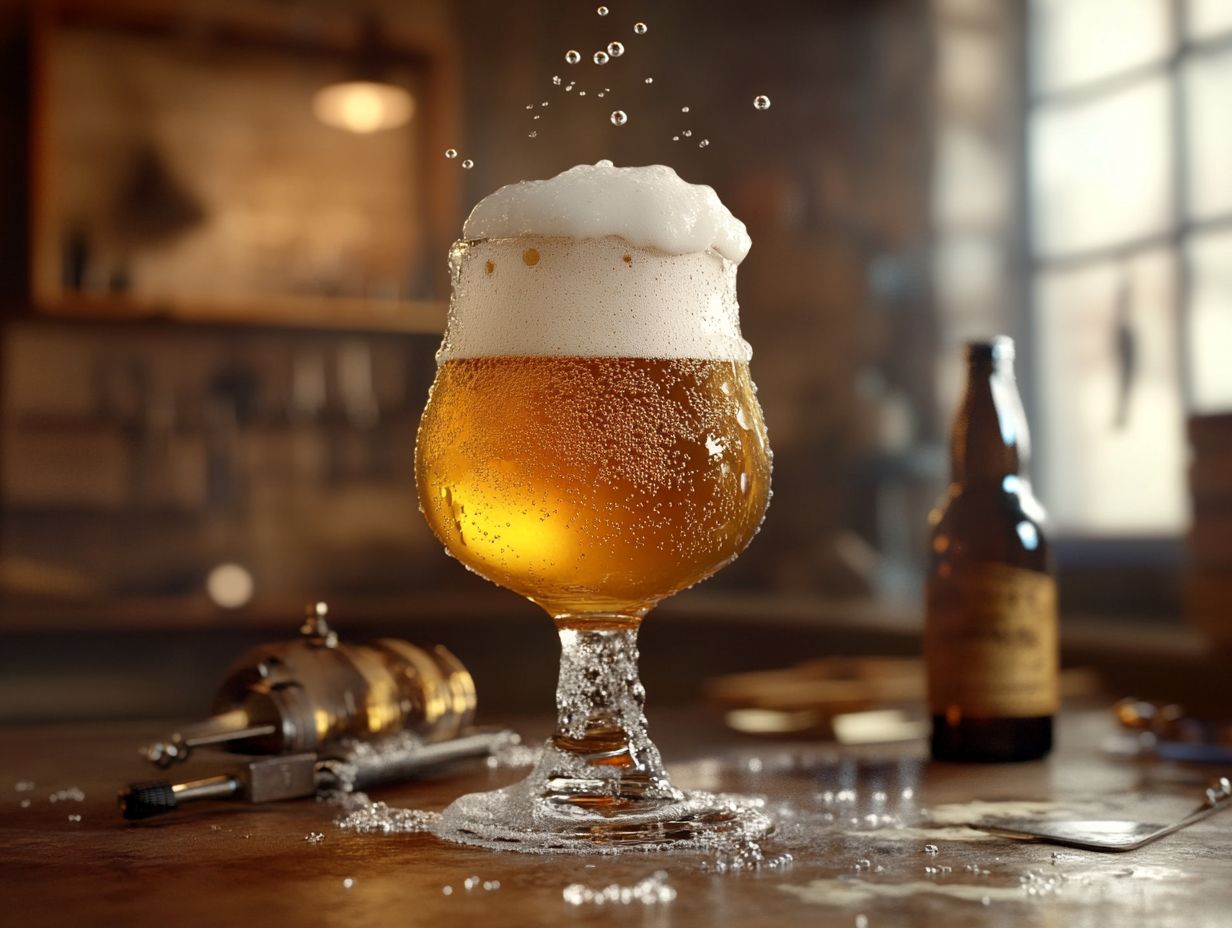
Blending overcarbonated beer with flat beer is an effective approach to achieving a harmonious balance in carbonation levels, enhancing your drinking experience. By combining the two, you can mitigate the excessive fizz of the overcarbonated beer while preserving its original flavors.
To execute this method, calculate the precise ratios, ensuring the final blend strikes the perfect balance neither overly fizzy nor devoid of effervescence. Start with a small sample of the overcarbonated beer and gradually blend it with the flat beer, adjusting based on your palate. For instance, blending an overcarbonated Columbus IPA with flat California Common could yield a delightful mix.
A blend ratio of 1:1 or 1:2 often proves successful. Taste along the way, allowing for adjustments to create a harmonious flavor profile. Chilling the beers before blending helps stabilize carbonation levels and ensures a smoother finish.
Try these techniques and share your experiences brewing beer with others!
Can You Still Drink Overcarbonated Beer?
While drinking overcarbonated beer may not be the most desirable choice, it remains a viable option with a few caveats. Excessive carbon dioxide and unwelcome gushing can be bothersome, but the beer is still drinkable.
As you navigate the world of overcarbonated beer, you might find yourself confronted with excessive foam or flavors that seem out of sync. These factors can certainly diminish the pleasure you expect from exploring different beer styles. You can still enjoy your beer tasting experience by being cautious and following expert advice.
Frequently Asked Questions
How Do I Know If My Beer Is Overcarbonated?
If your beer is overcarbonated, it will have excessive carbon dioxide (CO2) levels, causing too much foam, a fizzy mouthfeel, and a potential explosion when opening the bottle or can.
What Causes Overcarbonation in Beer?
Overcarbonation in beer is usually caused by adding too much priming sugar during the carbonation process or bottling or kegging the beer before it has finished fermenting. Using the wrong type of yeast can also contribute to this issue.
What Are the Signs of Overcarbonation in Beer?
The most common signs of overcarbonated beer include excessive foam when pouring, a fizzy or prickly mouthfeel, and a taste that is more carbonated than desired. It may also have a yeasty or sour smell.
Can Overcarbonation Be Fixed?
Yes, overcarbonation can be fixed using various methods such as releasing excess pressure, adding a pinch of sugar or yeast, or blending with flat beer.
Overcarbonated beer often can’t be saved and should ideally be discarded. However, if you catch it early, you could try opening and recapping the bottle or keg to release some carbonation but this isn’t always a sure fix.
How Can I Prevent Overcarbonation in My Beer?
To prevent overcarbonation in beer, be sure to properly measure and add priming sugar. Allow enough time for the beer to finish fermenting before bottling or kegging, and choose a yeast specifically designed for carbonation.
Can Overcarbonated Beer Be Dangerous to Drink?
Overcarbonated beer can be dangerous if it causes an explosion when opening the bottle or can. It can also be unpleasant to drink due to the excessive foam and carbonation. It is best to discard overcarbonated beer to avoid any potential danger.
